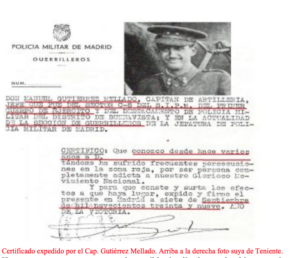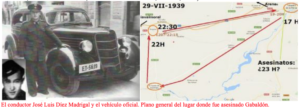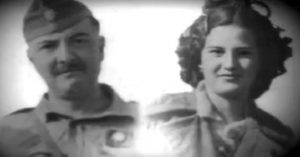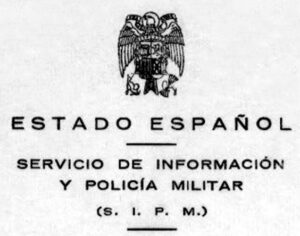Power takes on a subtle, flexible, intelligent form and escapes visibility. The subjected subject is not even aware of his subjugation. Hence it is presumed to be free.
-Byung-Chul Han

The importance of context
The 30s of the last century were one of the most tumultuous moments in recent history, both at the european and national levels. Europe was in the fever of war with some nations that glimpsed on the horizon the rival armies. On the other hand, Spain was going through one of the most unstable historical periods of its history with a Republic watering on all sides and whose stability was an entelechy.
European societies were more polarized than ever. Radicalism was rampant, and Spain was no exception, so much so that before World War II began, Spain served as both an ideological and military laboratory, so that in 1936 the Spanish Civil War broke out as a result of the uprising of the so-called national side.
After three years of a conflict that would change the face and history of Spain forever, the conflagration came to an end with the victory of the rebel side, also known as the national side. This new stage was characterized by the arrival to power of General Franco, who would rise as the visible and only head of the new political regime that would last for forty years.
This political regime was influenced by a political phenomenon of its time, fascism. Although characteristics of fascism can be found within it, Francoism showed its features that would make this regime a political phenomenon different from other totalitarian or authoritarian regimes.
Although it is not the task of this work to delve into the political characteristics of Francoism, it is essential to mention that Francoism showed a stance of rejection towards various currents of thought that could endanger the survival of the Spanish nation, according to the ideals of the regime. Namely, leftist ideologies in multiple variants -socialism, communism, social democracy, anarchism-and various doctrines that could be considered philosophical doctrines or currents of thought, such as Freemasonry. Hence, it has remained in the collective unconscious of "a Judeo-Masonic-Communist conspiracy," referring to one of the lines of thinking of the Franquist doctrine and the opposition to those currents of thought.

An example of this statement is that the rebels -even before the victory against the republican forces- were fighting against these ideas for years. Concerning this, we will carry out this work in which we will analyze a curious case about which there are more doubts than answers and to which we do not have an answer, quite the contrary. Anyway, the goal is not to know what happened, but what we intend is to use it as an example when analyzing a vital phenomenon that exemplifies one of the most relevant elements in political warfare. We refer to infiltration and how this phenomenon can be helpful for certain actors in a conflict whose objective is to influence a specific political system.
As we have said, there is hardly any information about the case we are going to analyze. At this point, the little information that exists is either biased or partially censored. Anyway, it is still a curious case that can help us understand the phenomenon of infiltration and subversion in a particular political system to attack it from within and subvert the existing order, something that is not necessarily sought in a short period, but that the subversion of the current order can be a long-term goal. It is done little by little until it manages to filter the most relevant circles of the political system. Be that as it may, and as we have said, we do not intend to unravel the reality of what happened but to use the case to understand a fundamental element in the field of political warfare.
Scapegoat murder
First of all, we need to meet the story's protagonist; we talk about Eugenio Isaac Gabaldón Irurzun, better known as Commander Gabaldón, who was killed after the Civil War ended.
Major Gabaldón was a member of the Military Police Information Service (SIMP). His functions could be defined as intelligence; his work was based on collecting information of people for the regime's secret services. Fundamentally it was information related to what the Franco regime identified as terrorists, infiltrators, and Freemasons. It should be noted that the assassination of the commander took place on July 29, 1939, that is, a few days after the end of the Civil War, so evidently, the activity of the commander was carried out mainly during the war years. At the same time, it is also striking that the assassination was carried out a few days after the war. With the change of political regime, it is easy to think that many of the commander's people were probably going to receive some reprisal, maybe the death penalty.
 Regarding the motivations for the murder, there are two fundamental hypotheses. The first is that the assassination was simply a settling of scores against Commander Gabaldón by some member of the new Franco regime, i.e., that the late motive for the assassination could have been some personal matter against Gabaldón; the second hypothesis, and the one that in our opinion has a more solid basis given the events that took place during and after the assassination itself, is based on the fact that Commander Gabaldón might have sensitive information about specific persons and the assassination was a way to, on the one hand, extract that information - which Commander Gabaldón had in a notebook known to have been taken from him on the day of the assassination - and on the other hand, to send a message to those who wanted to gather sensitive information about specific persons.
Regarding the motivations for the murder, there are two fundamental hypotheses. The first is that the assassination was simply a settling of scores against Commander Gabaldón by some member of the new Franco regime, i.e., that the late motive for the assassination could have been some personal matter against Gabaldón; the second hypothesis, and the one that in our opinion has a more solid basis given the events that took place during and after the assassination itself, is based on the fact that Commander Gabaldón might have sensitive information about specific persons and the assassination was a way to, on the one hand, extract that information - which Commander Gabaldón had in a notebook known to have been taken from him on the day of the assassination - and on the other hand, to send a message to those who wanted to gather sensitive information about specific persons.
The assassination itself and how it was carried out give us indications that it was not an ordinary assassination. The motivation for it had to be related to the information that Commander Gabaldón possessed. Why?
In this regard it is crucial to think about the material authors of the crime, we have Francisco Rivades Cosials who was a member of the PCE and during the war had been a lieutenant in the red army; Damián García Mayoral who during the war had been an officer on the red side; and finally Saturnino Santamaría Linacero, the three men were part of the Unified Socialist Youth (JSU), an organization that after the war was trying to reorganize and whose leadership fell on a certain José Peña nicknamed "El Gordo", who -and this fact may be relevant- had been arrested a few months before the murder of the commander and who curiously had revealed names and information about the members of the JSU, so it would not be unreasonable to think of two possibilities; either that people within the regime knew that the assassination of Commander Gabaldón was being planned and decided to do nothing, or that certain people within the government were interested in the death of the commander and provided material support to these three members of the JSU to kill the commander and subsequently kill the three material authors of the assassination, thus eliminating any evidence of the assassination.
So, let us continue to watch the unfolding of events to understand what might have happened. Most importantly, to see how the regime's infiltration might have worked and the importance of infiltration in waging political warfare.
One question we have is how three members of the JSU were able to get hold of national army material, as the uniforms they wore arouse suspicion. Most importantly, how they were able to leave Madrid to travel to Talavera de la Reina (Toledo). It must be noticed that although the assassins had uniforms of lieutenant, ensign, and soldier, the truth is that the war had recently ended, so the movement throughout Spain was not free but controlled. To leave Madrid, they needed safe conduct that the Military Police only granted. It is difficult to understand how three members of the JSU of whom the information was known and even what they planned to do, left Madrid without significant problems. This lack of control makes us think that the regime already knew who the three assassins were and their objective. In this regard, it is essential to know that days before the assassination of Commander Gabaldón, the Secretary-General of the JSU, Sinesio Cabada Guisado, known as "the Pioneer," had been arrested. So it is not unreasonable to think that the Pioneer would have informed the Military Police of the intention of the three assassins towards Commander Gabaldón.
 That said, and without going into details of the assassination, the three members of the JSU managed to reach the commander who at that time was in Talavera de la Reina. The assassination can be sequenced with the three assassins wearing their uniforms stopping the car of the commander -who was with his driver and daughter-. Following the three men entered the vehicle, and after a few meters - 150 to be more exact- they took out their pistols and forced the three occupants to get out. They killed right there.
That said, and without going into details of the assassination, the three members of the JSU managed to reach the commander who at that time was in Talavera de la Reina. The assassination can be sequenced with the three assassins wearing their uniforms stopping the car of the commander -who was with his driver and daughter-. Following the three men entered the vehicle, and after a few meters - 150 to be more exact- they took out their pistols and forced the three occupants to get out. They killed right there.
Once the assassination was committed and the supposed notebook of the commander with the information of numerous people was stolen, the three assassins immediately returned to Madrid, where they had been arrested 48 hours later. Finally, they were shot just a week later, on August 5. How is it possible that days before they left Madrid without significant problems, from such a highly controlled area, two days after the assassination, they were arrested so quickly? There is a curious fact, although the three killers were executed relatively quickly, there was one person who was not. At least not so immediately -he was shot on September 15-we are referring to Sinesio Cabada el Pionero, the Secretary General of the JSU who before the assassination was arrested by the Military Police. El Pionero had a meeting with the then Captain Gutiérrez Mellado. We will never know the reason for this interrogation or if it had anything to do with the assassination of Major Gabaldón. What is remarkable is the role that Gutiérrez Mellado will have in the future, especially at the time of the Transition, that is, in the transition from the Franco regime to democracy.
Concealment
The assassination of Commander Gabaldón had more consequences, as it seems that people close to the commander were aware of Gabaldón's work and the implications this could have. It is essential to note the position of the commander himself before his assassination, as it appears that on May 12, 1939, two months before his assassination, Gabaldón had requested his boss, Emilio Fernández to leave the SIMP. What was the reason for the request? It seems that Gabaldón had suspicions that there was a certain degree of surveillance and spying on him, so much so that one day when he was at home with one of his sons, he asked him to turn off the light because he might be spying on him. Having said this, we could reasonably think that it was paranoia on the part of Major Gabaldón. Still, the truth is that his request to leave the SIMP was rejected by his direct superior, Lieutenant Colonel Bonell Huici, who was responsible for the SIMP for General Carroquino's division, who was in charge of the division in which Gabaldón was carrying out his duties.
It should be noted that General Carroquino wanted to clarify the murder of Major Gabaldón but unfortunately died in a traffic accident two months after the Gabaldon murder. Although it may be something fortuitous and casual, we observe several other murders of people very close to Gabaldón. But before going to these deaths should be visualized SIMP organigram. On the one hand, we have General Ungría, who was the director of the SIMP; Lieutenant Colonel Bonell, who was in charge of the SIMP for General Carroquino's division, and General Carroquino, who was in command of the division in which Gabaldón was working and who wanted to clarify the assassination of Gabaldón. Of these four people, two died, one murdered and the other supposedly in a traffic accident. The remaining two, General Ungría and Lieutenant Bonell, were supposed to be Masons since they appeared in the lists of members of lodges. Indeed, we cannot be sure that this was so. Still, the drawing of the structure and the relationship of some high-ranking members within the SIMP with Freemasonry is striking. If so, it would be a fantastic example of how infiltration can work and its importance.
We had pointed out that after the commander's assassination, there were several deaths of people close to his entourage, making us think that perhaps there was a specific interest in never knowing why commander Gabaldón died and what was behind his assassination. On the one hand, we have the death of the Falangist Jacinto Alcantara, Gabaldon's assistant, and who was found dead one day after the commander's death. Also, on August 18, 1939, another Falangist and confidant of Gabaldon named Antonio Perez Asperilla was killed in El Retiro by his girlfriend, Amelia Treviño, daughter of Manuel Treviño, both Masons, according to information from the Military Defense Archive. Both the daughter and the father would be executed since Amelia Treviño confessed to her crime.
Conclusion: Infiltration, a possibility
The truth is that there is hardly any documentation -at least public- to serve as a reference when comparing sources, so much so that after consulting different newspaper libraries such as the Portal of Spanish Archives (PARES), the ABC newspaper library, the Historical Press Library (under the Ministry of Culture) or the Digital Newspaper Library of the National Library we have only found the press release of Commander Gabaldón decease, Although we cannot affirm that this is something rare, the absence of information is striking, perhaps due to the type of work carried out by the commander, who was part of the intelligence services of the regime, or perhaps due to the time in which the events took place during the post-war period.
Be that as it may, what is striking is that the case reached the highest levels of the regime, so much so that the case fell not only into the hands of General Yagüe but also of Francisco Franco himself [1], not leading to a clarification of the murder.

As exciting notes, but which do not go beyond the realm of pure speculation, it is interesting to highlight the figure of both Gutiérrez Mellado and Arias Navarro. They at that time had a relationship with the SIMP from the legal field. Both figures would end up years later reaching the Presidency of the Government (Arias Navarro) and the Vice-Presidency (Gutiérrez Mellado) after the attack against Carrero Blanco. This event would inevitably lead to the last throes of the Franco dictatorship. It should be noted that Carrero Blanco was convinced that the enemies of Spain -as we had indicated at the beginning of the work- were both Freemasonry and Communism. In a certain way, the shadow of Freemasonry reaches the case of Commander Gabaldón fully, as we could see with the relationship of many involved in the assassination, especially members of the SIMP as well as Captain Gutiérrez Mellado.
Finally, and as a curious note, we can also highlight the figure of a Soviet defector named Anatoliy Golitsyn, who in the sixties claimed that there was the presence of Soviet agents located in the high spheres of Francoism, something that could fit with the fact that the CIA supposedly informed Adolfo Suarez that Gutierrez Mellado worked for the KGB.
The last notes are only speculations based on some connections that can be observed with the assassination of Commander Gabaldón, correlation does not imply causation, but it is no less helpful to have analyzed this case to see how infiltration can become a handy element for political warfare.
The Infiltration of elements in a political system with the aim of both destabilizing it and gradually provoke actions leading to a possible change of framework - cultural, legal, political - helpful to the interests of both internal and external actors is crucial and can mean the difference between the success or failure of the political warfare. The important thing is to have the capacity to reconfigure the distribution of power; this may take a short time or be considered a long-term strategy, which would correspond more to the case we have analyzed. In this case, we must not forget another constant element throughout the development of all the events; secrecy. The ability to carry out a large number of actions, be they assassinations, interrogations, blackmail, sabotage, etc., without this information transcending and reaching instances that could make this information public and undermine the interests of the actors interested in the change of the political regime.
[1] "The various courts-martial that have seen the assassination of Commander Gabaldón have been the Diligencias Previas 110.133, joined to Case No. 37.038 (1939, 1942) against Sinesio Cavada and 11 others, and the Legajo 3.157; the Summary Emergency Proceeding nº 49/1940 (against Sanguino and others); another similar one nº 55047/1946 (File 4.584, on the JSU); another similar one nº 1241/39-46; the Summary 30.426/1942 (File 1087); and, finally, the Summary Emergency Proceeding 103.370 (1944), initiated "by order of SE. El Generalísimo" and which includes the declaration of Gutiérrez Mellado on pages 61 to 69). They are in the Archivo Histórico de la Defensa." Colonel Manrique - 20 August 2019.
 Copyright secured by Digiprove © 2021 Quixote Globe
Copyright secured by Digiprove © 2021 Quixote Globe